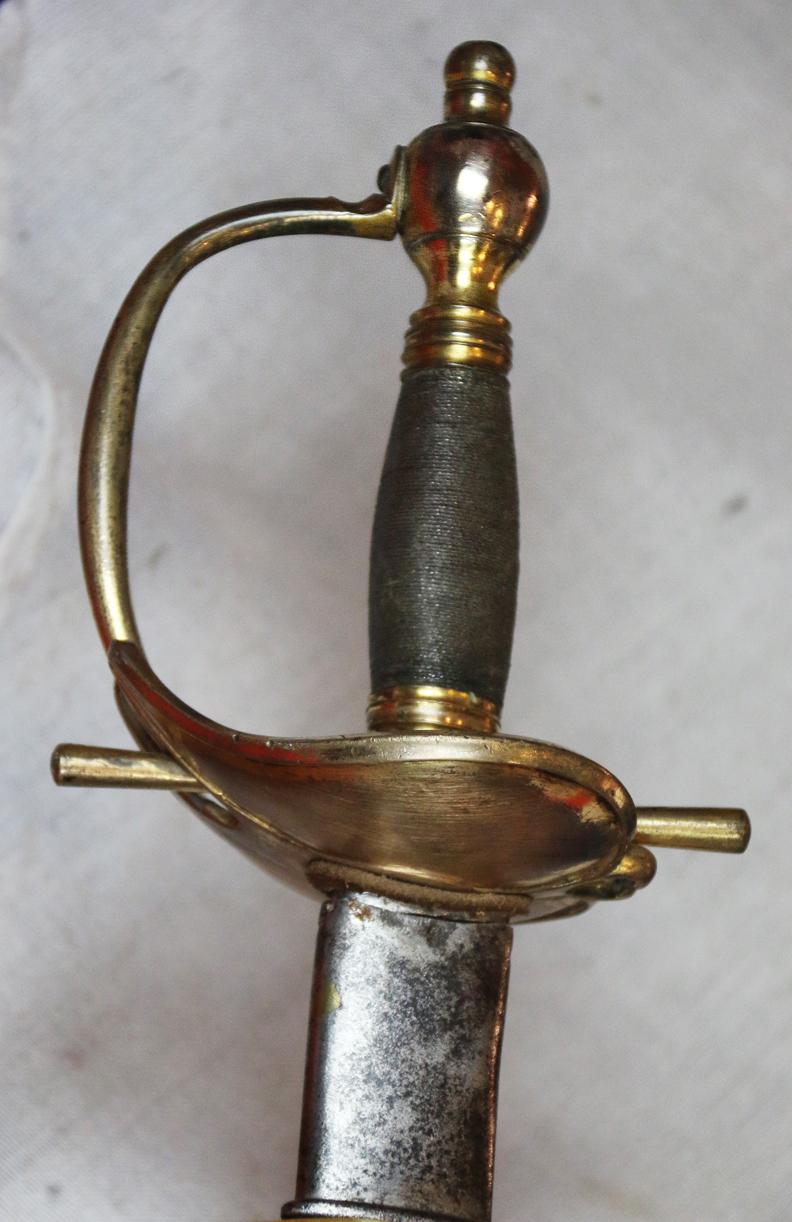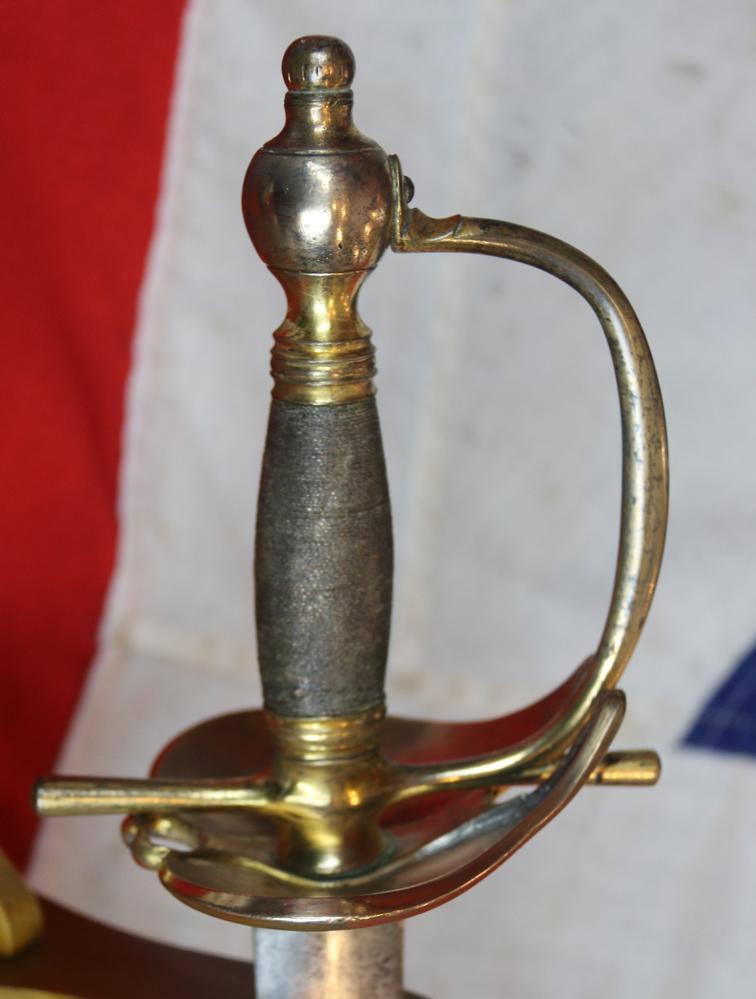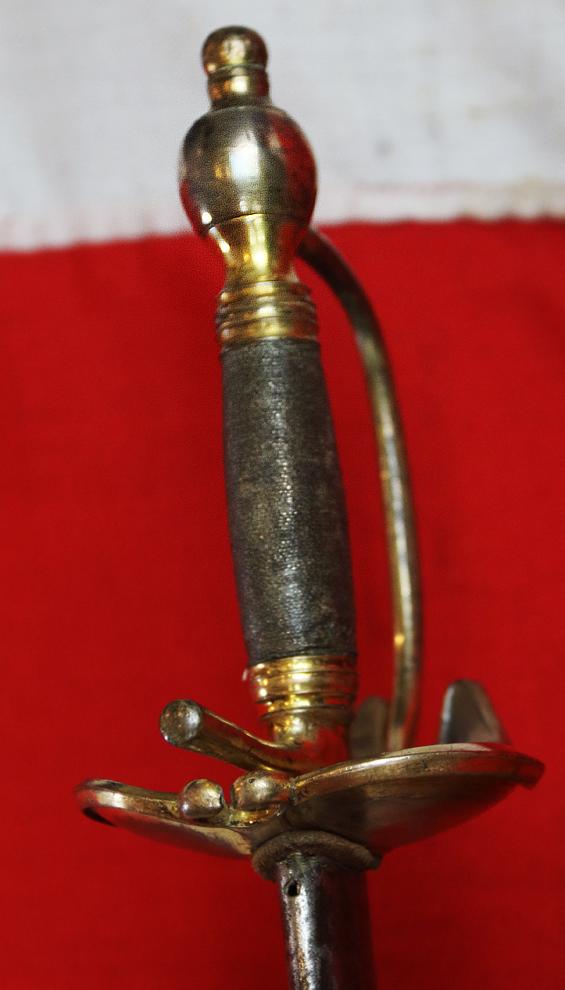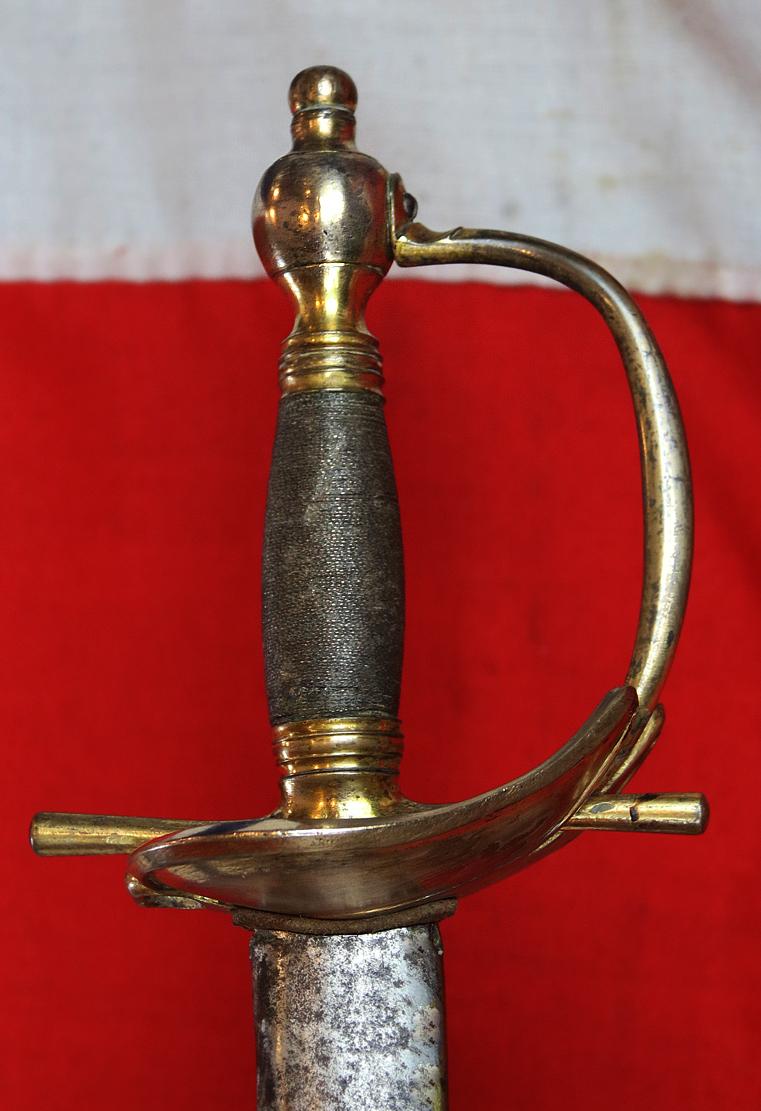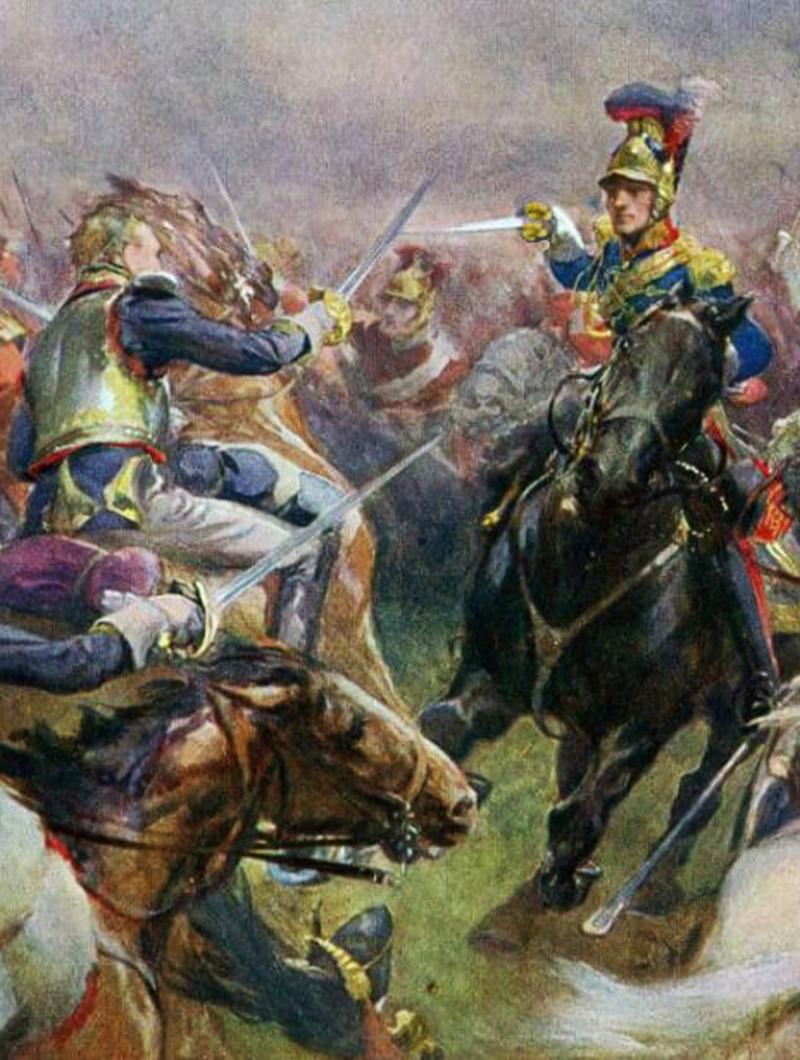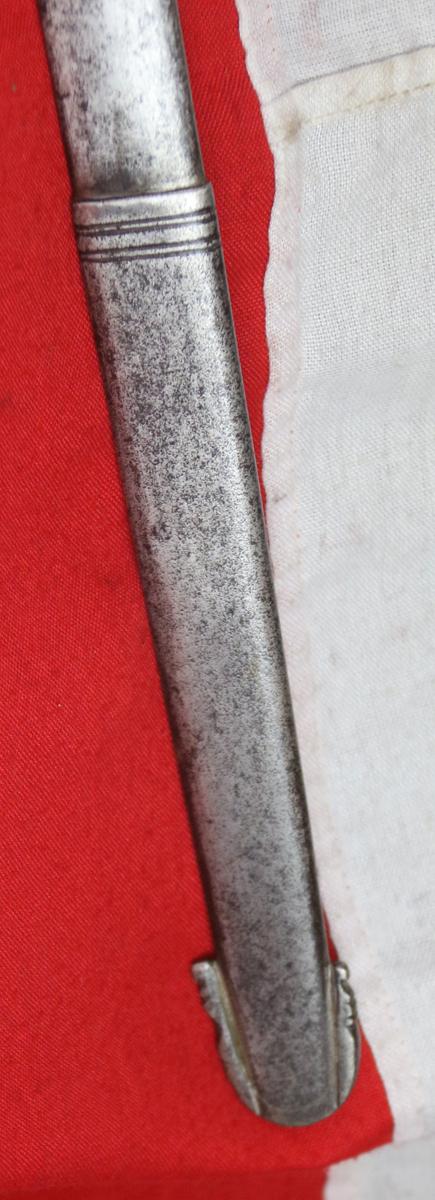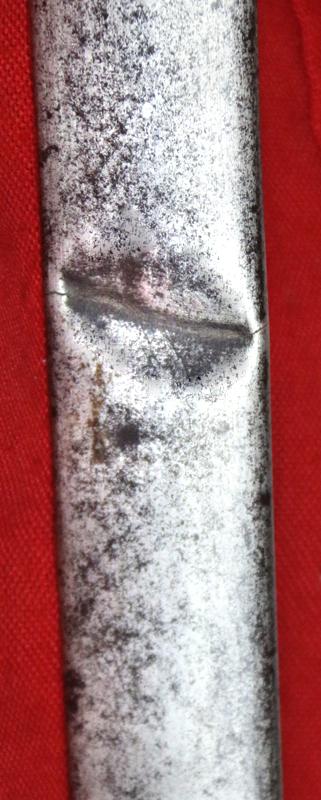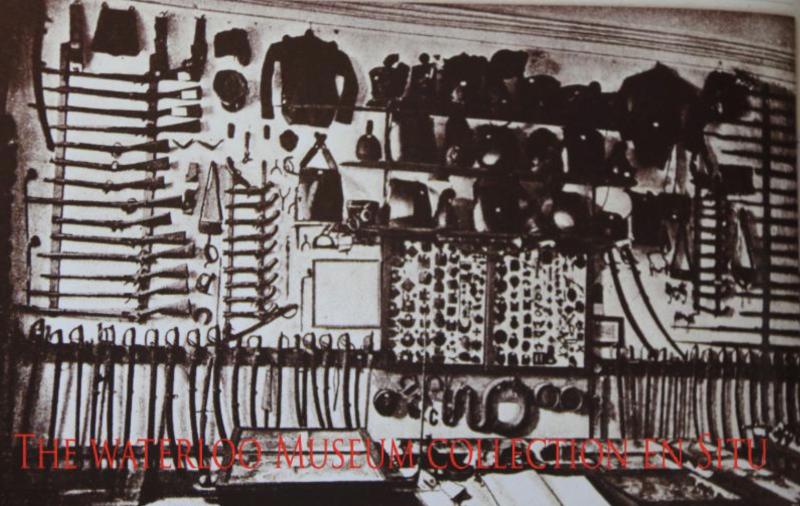A Superb, Original, 1796 Heavy Cavalry Officer's Sword, Napoleonic Wars and Waterloo Period, with a Broadsword Blade, Steel Combat Scabbard with Close Combat Blade Impact
1796 regulation dress pattern copper gilt hilt, with boatshell guard, D-shaped knuckle bow, urn-shaped pommel, wire bound grip, double edged broadsword blade contained in its all steel combat scabbard, which bears a single blade cut from another sword see photo 10. Upper suspension ring mount lacking. A very good example of these most desirable and beautiful of Napoleonic wars era swords used by an officer in the British heavy cavalry.
It has the traditional 1796 'boat shaped hilt' in copper gilt, in very good order bearing much of its original mercurial gilding, it has its original wire bound grip, a good broadsword double edged blade, and all steel combat grade scabbard.
Used by a Napoleonic wars period officer of the British heavy cavalry, serving in either the Union Brigade, or the 1st Household Brigade.
The Heavy Cavalry regiments were separated into two brigades at Waterloo. The 1st Brigade, known as the Household Brigade, commanded by Major-General Edward Somerset (Lord Somerset), consisted of guards regiments: the 1st and 2nd Life Guards, the Royal Horse Guards (the Blues), and the 1st 'King's' Dragoon Guards The 2nd Brigade, also known as the Union Brigade, commanded by Major-General Sir William Ponsonby, was so called as it consisted of an English (1st, 'The Royals'), a Scottish (2nd, 'Scots Greys'), and an Irish (6th, 'Inniskilling') regiment of heavy dragoons. More than 20 years of warfare had eroded the numbers of suitable cavalry mounts available on the European continent; this resulted in the British heavy cavalry entering the 1815 campaign with the finest horses of any contemporary cavalry arm. They also received excellent mounted swordsmanship training. The two brigades had a combined field strength of about 2,000 (2,651 official strength), and they charged with the 47-year-old Uxbridge leading them and little reserve Scots Greys Regt. The Scots Greys, as part of the Union Brigade so called as it was made up of a regiment of Heavy Cavalry from each part of Britain were some of the finest heavy Cavalry in Europe and certainly one of the most feared. A quote of Napoleon of the charge at the Battle of Waterloo goes;
"Ces terribles chevaux gris! Comme il travaillent!" (Those terrible grey horses, how they strive!) At approximately 1:30 pm, the second phase of the Battle of Waterloo opened. Napoleon launched D'Erlon's corps against the allied centre left. After being stopped by Picton's Peninsular War veterans, D'Erlon's troops came under attack from the side by the heavy cavalry commanded by Earl of Uxbridge including Major General Sir William Ponsonby's Scots Greys. The shocked ranks of the French columns surrendered in their thousands. During the charge Sergeant Ewart, of the Greys, captured the eagle of the French 45th Ligne. The Greys charged too far and, having spiked some of the French cannon, came under counter-attack from enemy cavalry. Ponsonby, who had chosen to ride one of his less expensive mounts, was ridden down and killed by enemy lancers. The Scots Greys' casualties included: 102 killed; 97 wounded; and the loss of 228 of the 416 horses that started the charge. This engagement also gave the Scots Greys their cap badge, the eagle itself. The eagle is displayed in the Royal Scots Dragoon Guards museum in Edinburgh Castle. The British Heavy Cavalry, during the Peninsular War and at Waterloo it fought with incredible distinction and exemplary bravery, and saw some of the most incredible and courageous combat. Fighting the elite French Curassiers and Carabiniers of Napoleons Imperial Guard was no mean feat, for at the time the French Cavalry was some of the most formidable in the world, and at their very peak. Never again was the French Cavalry to be as respected and feared as it was during the great Napoleonic era. Some of the battles this may also have been used at were; during 1808-14 The Peninsular Campaign, including, Salamanca , Toulouse, Albuera Talavera, Pyrenees then from 1814: La Rothiere, Rosnay, Champaubert, Vauchamps, Athies, La Fere-Champenoise and Paris
1815: and Quatre-Bras. The last photo in the gallery is of Lady Butler's painting, the Charge of the Scots Greys at Waterloo. One of the heavy cavalry regiments whose officers would have used in his service this very form of sword.
The swords used by the Union Brigade and Ist household brigade at Waterloo, have examples of their swords in the Royal Collection, The Tower of London Collection, the British Army Museum, and most of the finest British sword collections in the world.
The last photo in the gallery shows a photograph of one section of the collection in the museum of Waterloo, taken in around 1900, showing all the weapons of Waterloo en situ, including all the protagonists {British, French, Prussian and Belgian muskets, swords, pistols, armour uniforms, etc}. The museum was founded and owned by a veteran of the 7th Hussars that fought at Waterloo .
blade length 32 inches
Code: 24189



